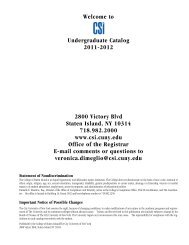Csi undergraduate conference on research, scholarship...
Csi undergraduate conference on research, scholarship...
Csi undergraduate conference on research, scholarship...
Create successful ePaper yourself
Turn your PDF publications into a flip-book with our unique Google optimized e-Paper software.
P O S T E R 3 5<br />
Engineering Printed Polymeric<br />
Superhydrophobic Surfaces<br />
Mark Barahman<br />
Faculty Mentor: Dr. Alan Ly<strong>on</strong>s<br />
Department of Chemistry<br />
Super-repellent surfaces pose an extraordinary<br />
opportunity for <strong>research</strong>ers. These surfaces display<br />
very high c<strong>on</strong>tact angles and low slip-angles with<br />
liquids. Research groups around the world have<br />
been motivated by the beauty of this phenomen<strong>on</strong><br />
and the potential real-world applicati<strong>on</strong>s of such<br />
coatings. These efforts have c<strong>on</strong>centrated <strong>on</strong><br />
creating coatings that exhibit very high roughness<br />
and low surface energy. Such coatings can be<br />
applied to devices for self-cleaning, n<strong>on</strong>-wetting<br />
and anti-icing purposes, and in many fields related<br />
to microfluidics, and fluid transport.<br />
We have been able to fabricate robust, low-cost, and<br />
highly applicable superhydrophobic surfaces and<br />
dem<strong>on</strong>strate the ability to tune the slip-angle of our<br />
coatings according to need. To achieve very low<br />
slip-angles (easy rolling), we have investigated<br />
introducing a sec<strong>on</strong>dary layer of roughness to<br />
printed silic<strong>on</strong>e features.<br />
This surface design is seen in what is perhaps the<br />
most referenced natural superhydrophobic surface,<br />
the lotus leaf (Nelumbo Nucifera), which gives the<br />
plant self-cleaning and water collecting abilities.<br />
A discussi<strong>on</strong> of the cause of this effect based <strong>on</strong><br />
c<strong>on</strong>tact-angle and slip-angle data, and several<br />
methods of microscopy will be included.<br />
P O S T E R 3 6<br />
Research Poster Presentati<strong>on</strong>s<br />
Analysis of Tau Over-Expressi<strong>on</strong> in<br />
Breast Cancer Cell Lines<br />
Kristina Toropova, Peter Hann<strong>on</strong><br />
Faculty Mentor: Dr. Jimmie E. Fata<br />
Department of Biology<br />
The Tau protein is a microtubule-associated protein<br />
that is abundant in neur<strong>on</strong>s of the central nervous<br />
system. It is known to stabilize microtubules by<br />
binding to both their inner and outer surface and is<br />
a critical regulator of chromosomal alignment and<br />
separati<strong>on</strong> during mitosis. Although Tau is<br />
predominantly found expressed in neur<strong>on</strong>s, it is<br />
also ectopically and abnormally expressed in breast<br />
cancer cell lines and tumors. In an effort to better<br />
understand the functi<strong>on</strong> of Tau in breast tumors, we<br />
have begun to examine the outcomes of overexpressing<br />
Tau in breast cancer cell lines. Here we<br />
report our findings, which indicate that over<br />
expressi<strong>on</strong> of Tau in two breast cancer cell lines<br />
suppresses Tumor Necrosis Factor alpha (TNFα)induced<br />
cell signaling. Our data has indicated that<br />
Tau can affect both pro-survival and pro-death<br />
outcomes in breast cancer cell lines. These findings<br />
have begun to provide insight into the functi<strong>on</strong>al<br />
significance of Tau in breast cancer cell lines may in<br />
turn influence therapeutic modalities.<br />
43





